 Who would have guessed that the big research questions of 2014 would be all about cats (okay, I’m biased)? Do cats really love us? Do they recognize our voices? Do they hate petting? Why do they love boxes? Does anyone understand them (even our vets?)? Why are cats so mysterious???
Who would have guessed that the big research questions of 2014 would be all about cats (okay, I’m biased)? Do cats really love us? Do they recognize our voices? Do they hate petting? Why do they love boxes? Does anyone understand them (even our vets?)? Why are cats so mysterious???
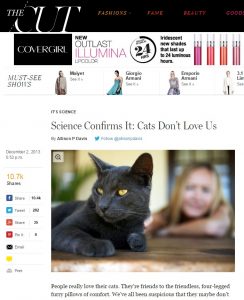 I wrote about several cat studies that came out in the last year or so: on whether cats ignore us when they hear our voices, whether cat bites are related to depression, whether play can prevent behavior problems, how people feel about stray cats, how little veterinarians know about cat behavior, and of course the yet-unpublished study claiming that cats aren’t attached to us.
I wrote about several cat studies that came out in the last year or so: on whether cats ignore us when they hear our voices, whether cat bites are related to depression, whether play can prevent behavior problems, how people feel about stray cats, how little veterinarians know about cat behavior, and of course the yet-unpublished study claiming that cats aren’t attached to us.
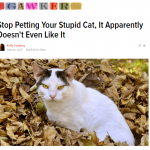 My very first blog post was about a study that came out at the end of 2013, suggesting that cats might find petting stressful (Turns out, the study was pretty well misrepresented by the media. My critique of the study here). Then in October of 2014, we were warned by Cats Protection (who did a non-peer reviewed survey) that most people don’t know what stressed their cat out (I mostly agree), and that petting could be stressful (key word is COULD).
My very first blog post was about a study that came out at the end of 2013, suggesting that cats might find petting stressful (Turns out, the study was pretty well misrepresented by the media. My critique of the study here). Then in October of 2014, we were warned by Cats Protection (who did a non-peer reviewed survey) that most people don’t know what stressed their cat out (I mostly agree), and that petting could be stressful (key word is COULD).
Now for my last blog post of 2014, let’s turn to a recent study about cats and petting – this time trying to get at the heart of the elusive needs of our fuzzy feline companions. In a study titled “The influence of body region, handler familiarity and order of region handled on the domestic cat’s response to being stroked,” Dr. Sarah Ellis and colleagues at the University of Lincoln looked at three key questions about petting cats:
- Do cats have preferred areas of the body for petting (or conversely, disliked areas)?
- Does a cat’s response to petting depend on whether the petter is familiar or not?
- Does it matter if you pet a cat head-to-bottom or bottom-to-top?
The sociality of the domestic cat is a rather recent feature (Cat 2.0 ®); but we know that some cats easily share close quarters with others and engage in affiliative behaviors such as allo-(or mutual) grooming and rubbing against each other. They especially like those “stinky” pheromone-filled areas, like the cheeks and forehead, where they have scent glands that communicate important social information.
Other species, such as cows and horses, prefer human handling that simulates handling they would experience during positive experiences with other cows and horses. The authors of the current study hypothesized that cats might have similar preferences, and like cheek and forehead pets best. A previous small study (only nine cats) suggested that cats like petting near the tail least of all, so the authors thought they might find a similar result this time around.
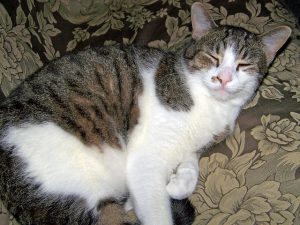
In experiment one, 34 cats who had been with their owners at least two months were tested. They were handled in eight areas (cheeks/lips, base of the tail, the forehead, the top of the head, the back of the neck, the upper back, the mid-back, and the chest), each area receiving 15 1-second strokes of the fingers. Each cat was handled in two separate sessions: one where they were petted by the owner, and one where the cat was petted by one of the experimenters (whether the owner or experimenter petted the cat first was randomized). The sessions happened on different days. All sessions were videotaped for behavior coding, which included both positive behaviors (such as self-grooming, blinking, closed eyes, rubbing into the hand, and kneading) and negative behaviors (including ears flattened, biting, quick head turns, swatting, and a swishing tail).
Results found no statistical differences for the number of positive behaviors recorded between owner petting (median score: 5 behaviors) or being petted by the stranger (2.5 behaviors). However, results suggested statistically MORE negative behaviors when petting was performed by the owner (median: 8.5 behaviors) than the stranger (5.0 behaviors). More negative than positive behaviors were recorded in general. Cats also showed the greatest number of negative behaviors for handling near the tail.
Experiment two was similar to the first, with 20 cats. The main question was whether petting should start at the head, and move to the back, and then tail, or the reverse. Half the interactions with the owner and cat were tip to tail, and the other half the reverse (in randomized order). Owners were allowed to pet their cats as they usual do.
Results showed no effect of start or end point for petting. In other words, cats don’t care if you start with the head or the tail, in general, they just dislike petting near the tail area! Now, many folks think their cat may actually like petting in that area. Many cats have an extreme reaction of head-turning and licking (see these videos):
There may be a few reasons cats get so worked up about being handled in this area. Especially for obese cats, it’s a tough area to reach. So it might be like having your back scratched in that one spot you can’t quite get to. It could be a bit of a “sensory overload” for some cats – and often petting here will lead to biting. Keep in mind that this area of the cat’s body gets a lot of “action” during mating, so some of these responses may be part of the reproductive process, which for cats has lots of biting, growling, hissing, and other feline pleasantries.
Okay, so on to the other findings. The authors were surprised to find that cats showed more negative behaviors toward their owners than strangers, thinking that familiarity would breed happiness, not contempt. Was it that the experimental situation was stressful? Were owners somehow inconsistent in how they handled their cats in the past?
A few things to keep in mind: one is that the difference in the number of behaviors, while statistically significant, was still pretty small (3.5 behaviors). The behaviors selected for coding may not have captured every detail that would really tell us how cats feel about the petting. I would love to know how the owners normally interact with their cats (Have they encouraged rough play? Do they like to tease or otherwise overhandle their cats?). Another possibility not entertained is that perhaps cats inhibit behaviors in the presence of strangers (fodder for a future study perhaps?).
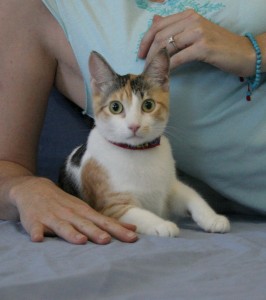
So, from the study, I have a few concerns about humans and cats. One is that regardless of the petter, cats showed more negative than positive behaviors during petting. This effect was driven largely by the petting near the base of the tail. Two studies have now confirmed that this is (in general) the cat’s least favorite place to be petted. Moral of the story – try NOT petting your cat near the tail area (even if you think she might like it). You might find that your kitty is more relaxed and enjoys other petting even more than she did before.
Second concern: the cats showed a great deal of variability in how they responded to petting in generaI. To me, this points out the important need for cat owners to learn and understand those positive and negative body language indicators, so that they can read their own cat’s preferences. The best way to be sure your cat will enjoy petting? Be gentle, avoid the tail, and let your cat tell you what she likes (and respect her wishes).

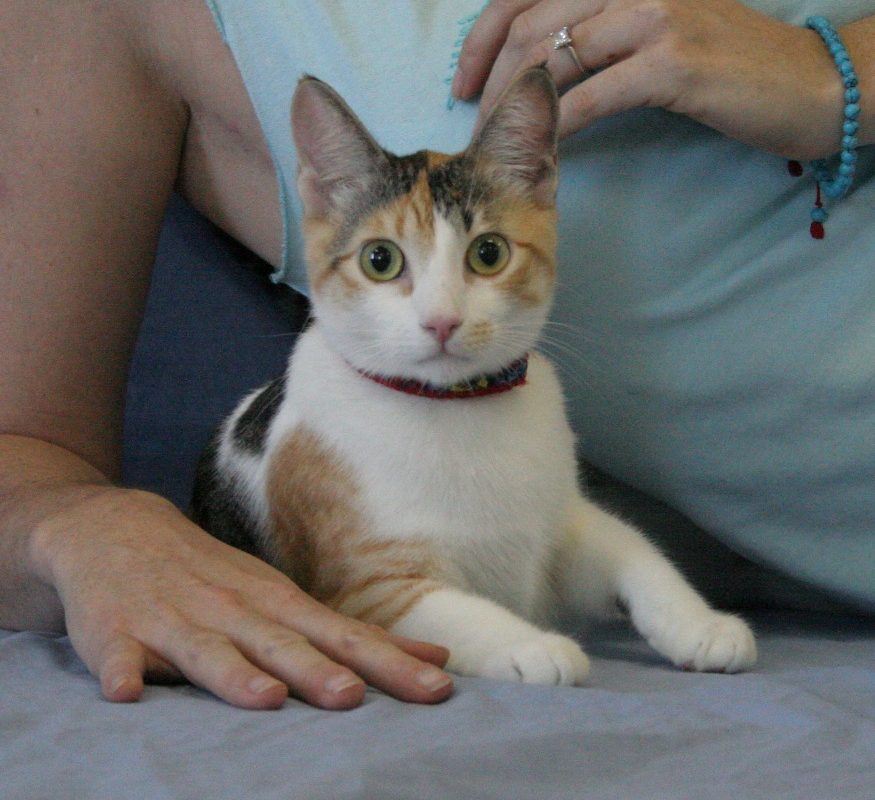
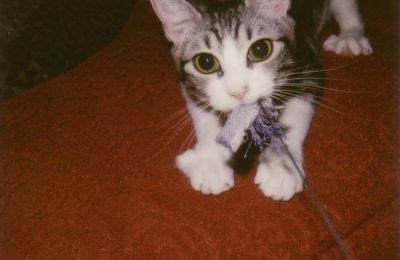
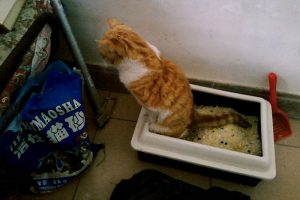
My cat loves being held in front of the mirror while I comb her. She purrs and chirps during the process. We do this 3 or 4 times a day 🙂 Her name is Gizzie <3
That is very cute! Thanks for reading!
Wow! Thank you very much for sharing!!! I always thought most cats enjoy being petted near the tail end. My own cat does not, but still your own cat is always easiest to read ofcourse. So again, thank you for this insight!
Thank you for reading Blanche!
Having had several cats over the years with very different likes and dislikes, every cat is different, what one cat likes, another may take great offense.
My current male, asks for the base of his tail and stomach to be scratched, and pads of his feet petted. You can pet in any direction and muss his fur as much as you want and he is one happy cat. My female in general does not like to petted. If she wants to be petted, she pets herself on your foot. She likes to cuddle between your legs with her head at your feel. She has a foot fetish, preferably bare.
I had another cat that did not care what you did to her as long as you were touching her. If you were not touching her, she would head butt your hand for a pet.
Another mail did NOT want the base of his tail or stomach touched. He did not like his fur mussed and ONLY petted from front to back. He also did not like to be brushed. He was fun to tease because his whiskers and bottom of his feet where ticklish. You had to be quick though or you would be scratched, bitten, or both.
Casey, you point out the importance of knowing your cat’s body language and individual preferences. I don’t recommend teasing cats though 🙂
oddly enough it was our dog that use to nip and be generally full of contempt, while the cat was the sweetest thing ever. First time i saw her she ran straight up to me and snuggled into my lap then just sat with me for a bit. She’s has spots she loves being patted, but never bites or scratches even if i touch her belly. she follows me around a lot, and while she is friendly with everyone, even strangers, she comes back to me when she wants to just lie down or relax. I’ve always thought that the temperament is based mainly on the personality of each individual then as the species as a whole.
Maya, I agree every cat is an individual, but when you work with lots of cats, you can certainly see some generalities. You just have to use those generalities as a guideline as you get to know your own cat’s preferences!
I had a cat who had seasonal fur with a winter coat and summer coat. During temperature changes with seasons, I would “fuzz” him to help him with the fur growth for each season. He would get cranky and wiggle around like in misery. It became our thing, I would leave his brush where he could get to it easily. He would come find me, meowing. I would tell him to show me what he needed. He would go over to the brush and meow. I would pick him up, get him settled on the couch and brush him how he indicated. I would bring a damp warm washcloth to rub off the static electricity which would cause him stress when it built up in his fur during fuzzing. It was a great way to help him ease thru coat changes, keep tufts of fur off the furniture, keep him from getting sick from hairballs, keep his mood down , keep peace in the household, keep fleas away and really help him to clean himself, as cats are self cleaning. I would also pet him backwards to get rid of excess fur. His beautiful fuzzy coat was too much for him to self-clean and manage at times. Also adding some extra oils, like fish oil or other healthy cat foods really helped the health of his furr and manageability for maintaining it. Static electricity built up in his coat during the dry, windy time of year. Adding oil rich foods recommended by his vet helped to reduce the static build up. He would nip at me, scowl, snap at me, scratch me during fuzzing sometimes. It was bc he shedded all at once some seasons. It was soo much fur!!!! I would have to get into the bath with him occasionally and use a vet recommended animal shampoo to gently shampoo him. Or else everything clung to his fur causing him insanity!!!! He was always fuzzing me!!!! That fuzzy cat!!!! I would say, “cat”. He would say “mrat”. I would say “yyeeaahh?” He would say “ mmrreeaah?” I leash trained him. I would take him on my errands. We’d smell all the lotions, deodorants, etc. I would let him pick out the scent he liked. We’d get kicked out of a store or 2 on occasion either bc he wasn’t allowed in the store 🏬 or bc letting him smell all the different shampoos was too much for store policy!! So we’d get the boot. It really gave him a calm down when he was involved in testing the smells of his human for allergies, displeasure, etc. He and I both had allergies so I used free and clear laundry detergent, I kept the dust off the furniture and vacuumed regularly to keep allergies from building up. Good luck with your fuzzy cat!!!
Thank you for article. Yes, I fully agree each cat is unique. I have a sweet ginger girl named Solis. I think because I’m a retired old man and Solis is my roommate, friend, and sometimes nurse coupled with I am her primary human, she tolerates or even likes certain things that would be intolerable from others. 😀